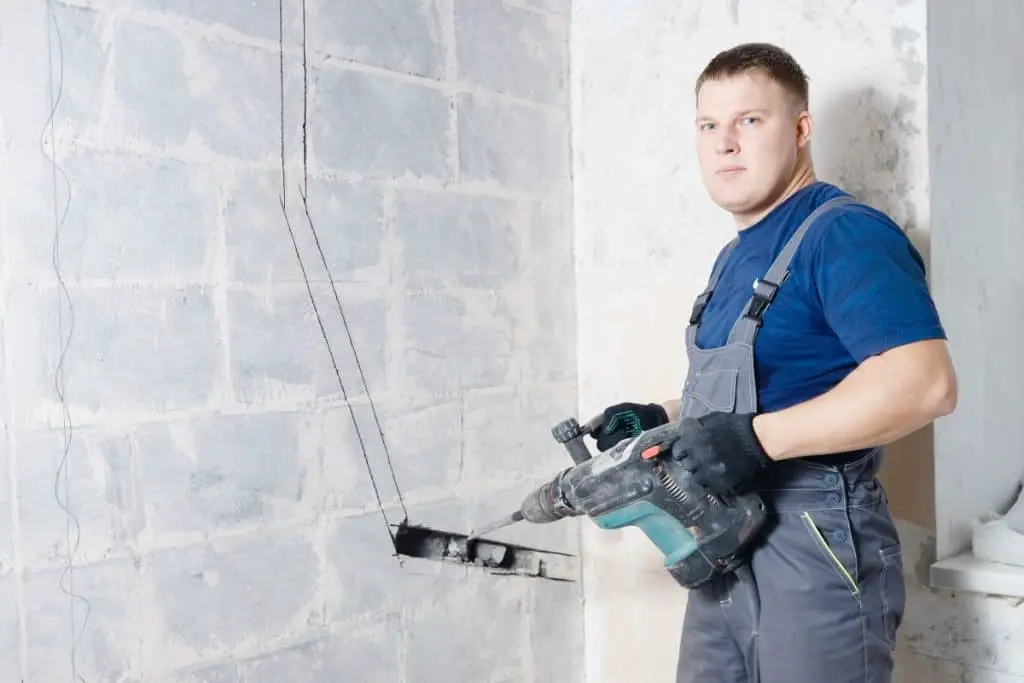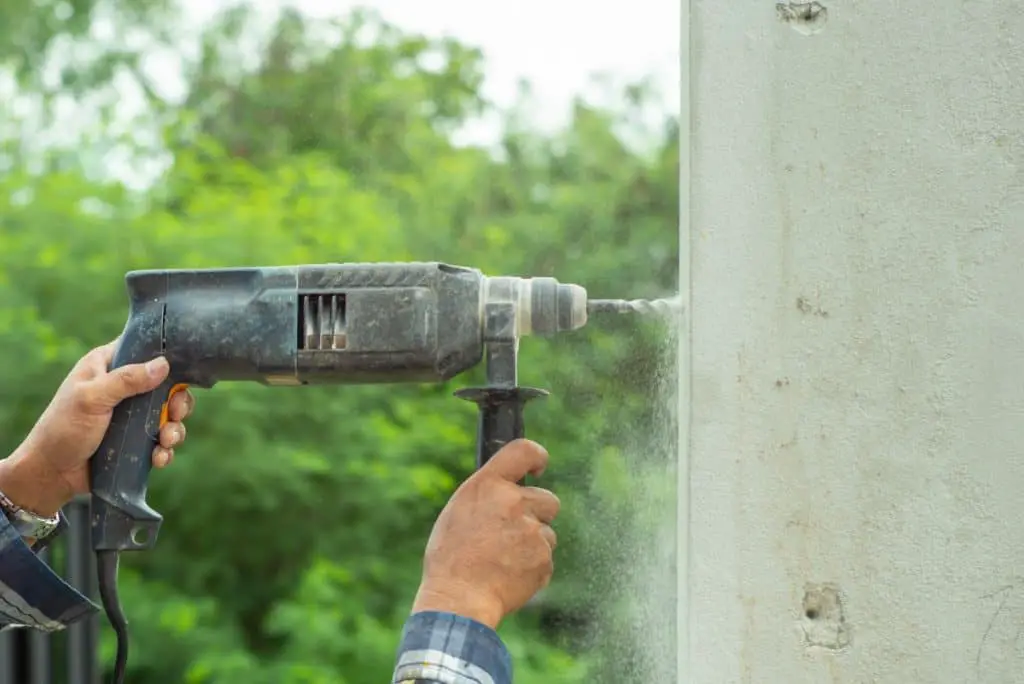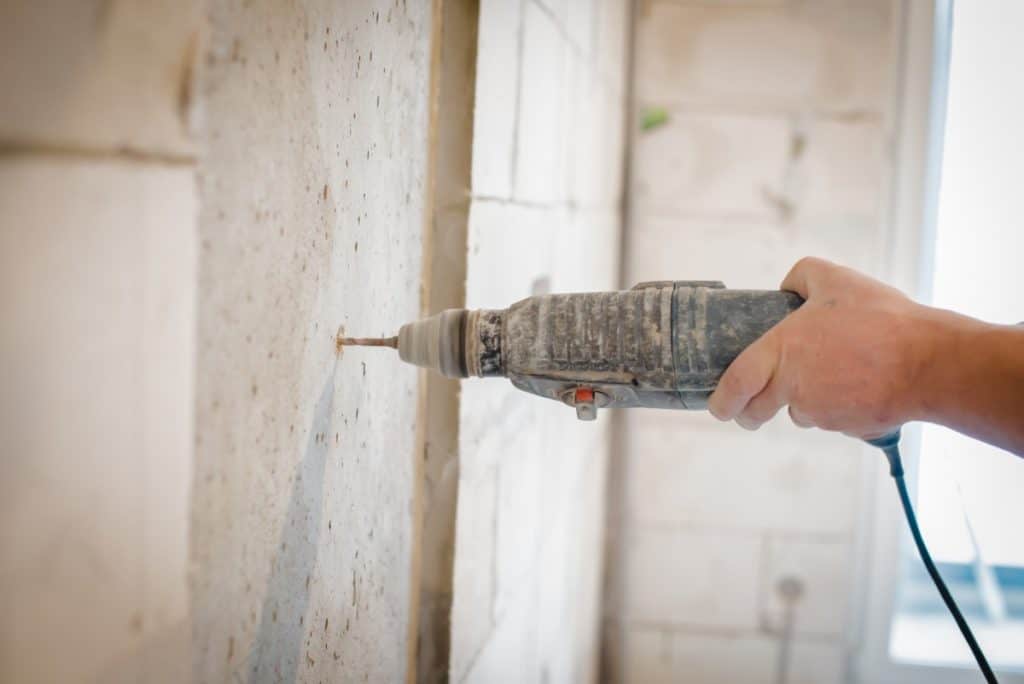Drilling into concrete certainly seems like it would be difficult, but it’s surprisingly simple when you know what you’re doing.
The drilling process for concrete is mostly the same it is with any other substance. The primary difference is in the tools that are required to penetrate the surface. Hammer drills and masonry drill bits are specialized tools that are very effective for drilling into concrete and brick.
The advice given here is actually applicable for any substance that’s similar to concrete as well. Brick, cement, or even stone can all be drilled through using the same tools and methods given here.

Table of Contents
What Tools Will I Need?
Aside from what’s absolutely necessary (a hammer drill and masonry drill bits), there are a few other useful tools that will make your project a lot easier if you have them on hand.
A masonry nail is similar in construction to your masonry drill bits, and while you may not need it every time you drill into concrete it’s always a useful thing to have when working on this kind of project. It can be used in conjunction with a hammer to help clear the path for the drill if that becomes necessary.
Masking tape and a pencil will be used to mark the spot where you want to drill before you start. This is absolutely worth doing since forgetting where you want to drill and putting a hole in the wrong spot can completely derail a project.
A can of compressed air will be used to clean out the hole after you’ve drilled it.
A vacuum cleaner will be your best friend while you’re cleaning up after the project. Drilling into concrete produces a ton of dust, and concrete dust contains lime, which is a really bad substance to breathe in. That means the faster and more thoroughly you can clean it up the better.
A masonry dust mask is also a vital safety precaution you’ll want to take to protect your lungs from the dangers of concrete dust. Make sure you have one before you start.
Safety glasses will do the same thing but for your eyes. Whenever you’re working with concrete you’ll probably want to have safety glasses on. They’re definitely worth having if you plan to do a lot of construction work inside or outside your home.
Ear protection is also something you’ll definitely need. Drilling through concrete is louder than you would expect it to be, and it will take more time to do drill through than regular wood. If you don’t have ear protection on, you can easily sustain permanent hearing damage.
Finally, you’ll want to take a look at picking up the two tools that are absolutely critical for this kind of drilling.
Hammer Drills

It’s technically possible to drill into concrete with an ordinary drill. It really should only be done as a last resort. In almost all situations you’ll want to get a specialized hammer drill instead.
So what is a hammer drill? A hammer drill is a particular kind of power drill that uses electricity not only to spin the drill bit but also to propel the drill bit forward into whatever it’s drilling into. This makes hammer drills ideal for drilling into tough materials like concrete or brick.
There are several big brands to consider when looking at buying a new hammer drill. Each of them has something a little different to offer, so make sure to do your research on each of them.
Most sources agree that the Dewalt hammer drill is the best in general. It tends to be a little pricier, but it makes up for that by being very powerful and having incredible battery power. However, it is also on the heavier side, meaning that it’s easy to get tired while using it.
If you’re looking for something a little lighter but just as powerful, the Bosch Bulldog Xtreme is a corded hammer drill that is much lighter and still perfectly capable of completing most jobs. It does tend to wear down a little faster than other brands though, so take good care of it if you do choose it.
The Black and Decker Hammer Drill is another corded hammer drill that’s much cheaper than the two previous mentions. It also shares some of the most important qualities with the two previously listed drills: Variable speeds. Having multiple settings is crucial for maintaining control over the tool.
Another cheap alternative is the Hammerhead, which runs on Amazon at prices under 45$. It does seem to be fully functional as well, although I haven’t ever used it before. If you’re looking for a budget option, this is probably a good one.
Masonry Drill Bits
An ordinary drill bit will not work for concrete. It will break long before you’ve achieved the depth you’re trying for, if not the moment you put it up to the surface. Even if you for some reason can’t get your hands on a hammer-drill, you need masonry bits for this project to be possible.
A masonry bit is different from a wood bit or a metal bit in a few notable ways, but the most visible is the tip. Masonry bits have fairly wide, gently sloped tips compared to wood bits in particular, which tend to have very sharp tips.
Masonry bits are also often coated in carbide to make them hard enough to pierce the brick or concrete they need to.
Related article: Are Titanium Drill Bits Good for Concrete?
Most brands that produce masonry bits make fine products, but since bits are much less expensive than drills are you’re much more likely to be able to afford a premium option. Just make sure the bit you buy is compatible with the drill you have.
Dewalt is, once again, a good choice for this. Their set does have enough options for most situations, and they are compatible with most drills. The EANNINO 5 Piece Concrete Drill Bit Set is a fantastic budget option, coming in at just about 7$ without sacrificing quality.
Drilling Into Concrete
The first thing you’ll want to do is mark the spot you plan on drilling into. Because the wall you’re drilling into is concrete, there’s no need to worry about accidentally piercing something important.
Once you’ve marked your spot, set that to the depth that you want to drill to if you have a stop bar on your drill. If you don’t have a stop bar, wrap a piece of masking tape around the bit to show where you want to stop.
You are now ready to start drilling! Don’t worry, you’ve got this. Make sure you’re using the bit you want, hold the drill like a handgun, and go to town! You must maintain control of the drill throughout the process, so make sure not to go any faster than you need to.
You’ll first want to make a small guide hole to help you maintain your control. For this, you’ll want to use a lower setting on your drill than you might otherwise. Take your time and be safe.
As you drill, you might run into some of the various pieces of gravel that are often a component of concrete. If something suddenly makes your drill stop progressing, stop drilling. These can damage your drill bit or worse, cause you to lose control, which could cause damage to your wall or yourself.

Instead, take that masonry nail you grabbed earlier. Using the nail and a hammer, you can tap on the hard spot until you’ve gone all the way through. This will keep your drill safe and it will keep things moving along at a reasonable pace.
When you’ve finished the guide hole, you can start the full hole. Keep steady and keep control. You can now probably turn the drill up to a higher setting and go a little faster.
When you’ve reached the appropriate depth, use the can of compressed air to blow out all the dust. Then vacuum up all the dust in the area with the vacuum cleaner.
What If I Can’t Get A Hammer Drill?
If it’s absolutely impossible for you to get a hammer drill in the amount of time you have, you can use an ordinary power drill as long as you have a masonry bit. However, it will take a very long time and if the concrete is especially old, you might still not even be able to do it.
The marking step is the same as before. Plan where you want the hole and how deep you want it to be. Prepare to start drilling, and be sure to pay close attention to your drill.
It’s easy for an ordinary drill to overheat while trying to push through such a tough material. This can even destroy your drill’s motor, so be careful! Start slow and speed up gradually if you speed up at all.
You’ll also want to start out with the smallest drill bit and then move one size up each time you get to the end.
If your drill does start to heat up, take a break and pour some cool water on it. This will help it cool down quickly. Then when you start drilling again, go slower so you don’t damage your motor.
Same as above, if you get stuck, use a masonry nail and hammer to clear the block. This is even more important now since your ordinary drill has a higher chance to sustain damage because it is not built as tough as a hammer drill.
All this is not an optimal solution to the problem. If there is any possibility of either renting or buying a hammer drill you should do that instead. It will be faster, easier, and safer. Plus, if you end up breaking your drill, you may end up spending the same amount of money anyway to get a new drill.




